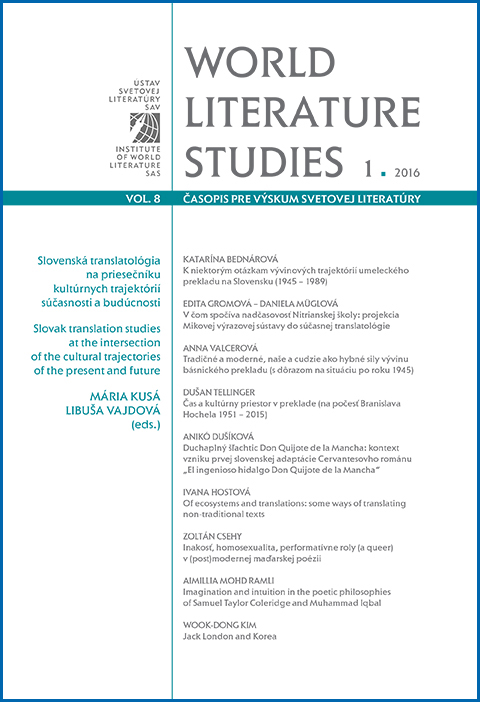Tradičné a moderné, naše a cudzie ako hybné sily vývinu básnického prekladu (s dôrazom na situáciu po roku 1945)
Translation of a poetic text as an expression of national culture
Author(s): Ana ValcerovaSubject(s): Language and Literature Studies
Published by: Ústav svetovej literatúry, Slovenská akadémia vied
Keywords: Poetry translation in Slovakia after 1945; Naturalization; Exotization; Modernization; Historization
Summary/Abstract: Terms such as naturalization, exotization, modernization and creolization were used by Anton Popovič in the so-called Holmes’s crisis in the 1970s, and they have since gone on to become a staple of Slovak translation theory. They rank among the most frequently occurring translation theory and translation criticism terms after equivalence and shifts. Moreover, their use may be considered as crucial when drawing up the Slovak history of translation in the 20th century. As individual periods in translation studies in our country take their turn, one of these tendencies always comes to the fore as the dominant one. After the clear dominance of naturalizing tendencies in the 1950s, when classic translations were preponderant, a predominance of up-dated translations appeared. This was introduced by Feldek’s appearance in the Mladá tvorba literary magazine at the end of the 1950s and throughout the 1960s by the dominance of modern literature. This alternation of dominant tendencies is by no means mechanical, but it is applicable also in hindsight. Whereas in the period of Realism naturalization tendencies (Kukučín, Hviezdoslav) seem dominant, the period of Modernism foregrounds those of exotization (Roy, Krasko). However, in the inter-war period, exotization takes turns with naturalization (Jesenský, Jesenská, Rázusová-Martáková). J. Felix praises these translations although with respect to historization and modernization he is in favour of so-called vivification, i.e. adapting translation to an epoch in which it originated as well as to the reader. Furthermore, Surrealists in the period of the Second World War and shortly before it seem to prefer modernization and exotization over naturalizing translations. Thus, they bridge the period of naturalization from the 1950s to the 1960s when they become closer with the starting generation of Concretists. Again, after 1968 modernization is not pushed to the background mechanically; prime translations are still modernizing or up-dated. After 1989, gradually after a wave of exotization, especially Americanization (shortly after the Revolution), one can observe an attenuation of the modernizing and exoticizing methods in supreme translations, those of poems, in particular, in contrast to what was referred to by Felix as vivification on a temporal axis and creolization, i.e. mixing of cultures, by Popovič. This is called an attenuated or classicist translation method; translation fulfils its basic role; it approximates to the style of a translated author and is at his service.
Journal: World Literature Studies
- Issue Year: VIII/2016
- Issue No: 1
- Page Range: 35-48
- Page Count: 14
- Language: Slovak

